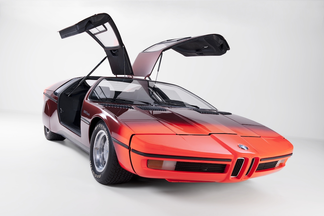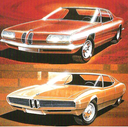Paul Bracq: a talented designer
- COCKPIT
- Jan 27, 2023
- 6 min read
You may not know his name, but you all remain fulfilled by his chisel, if you are told Mercedes SL "Pagoda", or the BMW Turbo, or even the simple Peugeot 205, does that give you a sketch?

his beginnings
Paul Bracq was born on December 13, 1933, at the age of 17 he became a student at Arts et Métiers and studied wood carving, but instead of sculpting furniture, Paul sculpting model cars, studies that he did not like, he therefore follows parallel training at the school of the Chambre Syndicale de la Carrosserie. It was there that he was noticed in 1952 by the monthly Automobile which devoted articles to model makers and showed two of his creations. Through Jean Bernardet of the magazine l'Automobile, he was recruited by Philippe Charbonneaux who owned a budding studio. He realizes for this stylist installed on his own account projects of advertising vehicles, he participates in the study of the Super bus Pathé Marconi, after 2 years of design, the Superbus is delivered to the French major in 1952 and wins the grand prize of honor of the "advertising that rolls" competition in 1955. He also participated in various bodywork projects based on Packard, Pegaso, Salmson...

In October 1954, he was called up for military service in Germany. His antecedents make him assigned to the garage of the General Staff of Hunting, abundantly provided with beautiful German cars. While driving a Mercedes 300 from the general staff to maintenance in Stuttgart, he took the opportunity to go to the brand's press service to ask for race posters, and to drop off drawings. Paul Bracq, having experienced the slow death of French coachbuilders directly at Philippe Charbonneaux, is well aware that the prospects in France are limited, while in Germany, a firm like Mercedes very quickly managed to reconnect with its great tradition. Eight days later, Mercedes contacts him. The manufacturer will wait until the end of his military service to hire him. The outbreak of the Algerian War forced Paul to wear uniform for another eighteen months. But Karl Wilfert did not break the contract and hired him in 1957.

At Mercedes a star is born
This is how Paul Bracq began working at Mercedes in 1957. He was placed under the direction of Karl Wilfert in the brand's style office. This early work concerns body parts such as lights. Then he actively worked on the creation of two emblematic models for collector car enthusiasts: the 230 SL and the 600, both presented in 1963.

With the 230 SL Pagode, Paul Bracq produced his first masterpiece in 1963. A subtle blend of classicism and avant-garde, the car draws its uniqueness from the great finesse of its lines, combined with a strong development of the roof and the glazed surface. In this, it shows thirty years in advance and announces the cars of today. Luminosity and transparency are part of the fundamental principles of Paul Bracq's art: "In a car, I have always liked to see clearly to better communicate with the environment. In order to increase the glazed surface, I lowered the line box and descended the pontoon. This transparency also contributes to safety. For me, the ideal pavilion remains the helicopter cabin".

The idea for the pagoda-shaped roof came from Béla Barényi, the man with 2,500 patents who heads the brand's project office. He had invented a symmetrical vehicle with a rather unusual appearance on the roof of which it was possible to settle down - for camping, for example. Paul Bracq takes up this formula and increases the height of the pavilion initially planned by six centimeters. The aesthetic success of the car is also due to an error made during the development of the project. Indeed, the width of the platform has been oversized. Instead of creating a new underbody, Karl Wilfert decided to widen the fenders by adding beads, thus creating a tangent wheel effect that lightens the silhouette.

Replacing the 190 SL but also the famous 300 SL, it evolved into the 250 SL in 1967, then the 280 SL in 1968, before giving way, in 1971, to the 350 SL of the new generation R107. As for the 600, this limousine with a V8 6.3 engine, had a career that only ended in 1981, after having driven many heads of state and wealthy industrialists. Paul Bracq is also behind the 250 S and 250 SE (W108) and 300 SEL (W109) sedans launched in 1965, and the 200-280 (W115-114) sedans marketed from 1968.
Paul Bracq remembers: "We painted the models in shiny black and, under the neon tubes, the lines of light traced on the body allowed us a visual check. The shiny black reveals the slightest defect in the modeling. saw a line of control slip by. Mercedes' talent was to put the work back on the job a hundred times. For six months, we sanded and spun... The brand's bodies drew their quality from this rigorous work carried out on the models. Thanks to the modeling, the sheet metal appeared thicker and the paint deeper. The thickness is an illusion resulting from the art of shaping the shapes. The chrome work was also very thorough. For a ring placed on the side of the car, we made ten to fifteen sections in order to choose the one that would best catch the light.The art of chrome consists in optimizing the part that reflects the sky to the detriment of the dark one, which is oriented ground ".

He worked at Mercedes with Bruno Sacco, future head of Mercedes styling from 1975 to 1999, on prototype bodies with Wankel engines, a technical solution in which Stuttgart believed at that time.

Bracq's drawers are then filled with drawings of the Mercedes of the future. But the big German house is slow in its evolutions, and the designer's proposals receive little response. At thirty, he is stamping with impatience...and he misses France.

Back in his native country, Bracq signs with Brissonneau and Lotz a French company of mechanical construction, especially of railway equipment and also since 1956 produces in small series the bodies of sports cars such as the Matra 530, and that of the Vauxhall 1900 GT. His friend Jean Bernardet informs him that the coachbuilder from Creil has a project to create a style office. Jacques Cooper and Paul Bracq are recruited and together they will design part of the "Turbotrain" which will later become known as the TGV.

He goes to BMW
The French coachbuilder had received an order from BMW for a V8 coupe for the American market. The project was scaled down from a 1600 Ti. The car was to be produced in Creil. But Brissonneau et Lotz was nationalized and then filed for bankruptcy. The project is stopped!
The leaders of BMW saw the opportunity to hire the man who had impressed them with the mythical Pagoda of Mercedes and carried out his first work for BMW at Brissonneau and Lotz with a design study based on the 2002. Case recorded, Bracq returned to Germany to lead BMW's design department.

It was thus that in 1969 Paul Bracq joined the style center of BMW, which only had a dozen people at the time.
“The trend in the 1970s was to design or design safe cars. BMW therefore had to respect this new path,” confirms Paul Bracq during an interview at his home in Bordeaux. “And then there was the event of the construction of the Olympic park for the 1972 games. This stadium was built on the old airfield that BMW used to test these aircraft engines between the two wars! Here too, BMW had to celebrate the Olympic event in its own way! The sales manager at the time, the famous Bob Lutz, then asked me to design a sports car with as much safety technology as possible and with, of course, a Turbo engine because we were about to market the 2002 Turbo.”

Perhaps his most famous work for the Bavarian group was his 1972 E25 Turbo concept car. A bold, futuristic mid-engine machine painted orange and red not only defined the (final) style of the M1, but also incorporated important safety systems into its design. Crushable foam-filled bumpers, a radar cruise control system, seat belts that had to be fastened before the engine could be started with BMW's ancestor control system It was a trick of technological strength. As well as being a stunning machine powered by a 2.0-litre turbocharged engine renowned for 280hp.
On his second return to France, he went to Peugeot

Paul Bracq, longed for his home country and after just four years at BMW he returned to France where he was employed by Peugeot as an interior design manager and over the next 20 years he was responsible for the interiors of the 305, 505, 205, 405, 106, 406 and 206 as well as many concept cars such as: Quasar, Proxima and Oxia and on the study of a Papamobile.
At the same time, Gérard Welter is in charge of the exterior styling.
The interior style, although considered a priori less noble than the exterior style, requires knowing how to create something comfortable, intimate, of which the driver does not tire, which is able to resist time with adequate materials.
In 1994, Murat Günak took control of the Peugeot style. Paul Bracq can legitimately wonder about the interest of having his work supervised by a newcomer.
He retired in 1996.

He may be retired today, but no doubt continues to paint and sculpt as he reflects on the incredible mark he left on some of the most iconic machines of the 20th century.










